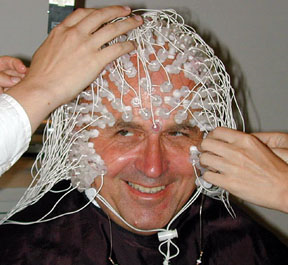Meditation and Leadership
January 21, 2007 by Bill Joiner
Filed under Research on Agility
 Why would the Wall Street Journal do a major article on meditation and the brain? (January 19, 2007, pp. B1-B2). Maybe Sharon Begley, the article’s author, intuited a connection between meditation and leadership similar to the one we found in our research. We found that managers develop mastery of leadership agility by moving through a series of five stages or levels. According to the research, 10% of today’s managers have not yet reached the Expert stage, the first level of leadership agility. About 45% operate at the Expert level, and about 35% at the Achiever level. Only about 10% have developed into one of the “post-heroic” levels of leadership agility: Catalyst (5%), Co-Creator (4%), and Synergist (1%).
Why would the Wall Street Journal do a major article on meditation and the brain? (January 19, 2007, pp. B1-B2). Maybe Sharon Begley, the article’s author, intuited a connection between meditation and leadership similar to the one we found in our research. We found that managers develop mastery of leadership agility by moving through a series of five stages or levels. According to the research, 10% of today’s managers have not yet reached the Expert stage, the first level of leadership agility. About 45% operate at the Expert level, and about 35% at the Achiever level. Only about 10% have developed into one of the “post-heroic” levels of leadership agility: Catalyst (5%), Co-Creator (4%), and Synergist (1%).
We found that majority of Co-Creator and Synergist leaders in our sample practiced some form of meditation. Forty percent of the Co-Creator leaders meditated every day, while another 10% did so in a more sporadic way. Among our Synergist leaders, 50% had a daily meditation practice, and 35% had a “semi-regular” practice. Many of these leaders practice a form of mediation associated with one of the world’s major religions, including Buddhist, Hindu, Taoist, Christian, Judaism, and Islam. Others practice forms of meditation that are distinctly areligious (for example, the “relaxation response” developed by Dr. Herbert Benson of the Harvard Medical School).
Other Co-Creator and Synergist leaders did not practice meditation, but all these leaders engaged in some kind of regular practice that developed more refined levels of attention and intention. And this is the key: They all sought to bring these heighened levels of attention and intent into their work as leaders. When you read the stories in the book about Co-Creator and Synergist leaders, you’ll see how their levels of attention and intention translated into corresponding levels of leadership agility.
One of the studies reported in the Wall Street Journal article was conducted at the Laboratory for Affective Neuroscience at the University of Wisconsin, Madison. As part of a collaboration with the Dalai Lama of Tibet, scientists recorded the brain waves of Buddhist “adepts” who had all practiced over 10,000 hours of meditation (a good bit more than the leaders in our sample). The adepts’ brain waves were compared with those of a set of volunteers who’d been given a crash course in meditation.
In both groups, MRI imaging showed that meditation activated those regions of the brain that generate positive feelings, such as happiness, as well as those regions associated with the regulation of movement and emotion.
Some of the novice meditators showed a slight but significant increase in gamma waves. These are brain waves associated with consciousness, integrated perception, and problem-solving. In the adepts, the gamma waves were much stronger. Not only that, in between mediations, the gamma signal in their brains never died down, and more practice with meditation correlated with stronger and more enduring gamma signals. In addition, the adepts had much greater activation in the brain regions that underlie empathy and maternal love.
Lab Director, Professor Richard Davidson, is quoted as concluding:
“This positive state is a skill that can be trained. Our findings clearly indicate that meditation can change the function of the brain in an enduring way.”
Many thanks to my good friend and colleague, Steve Stulck, for bringing this article to my attention.
